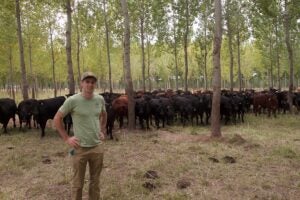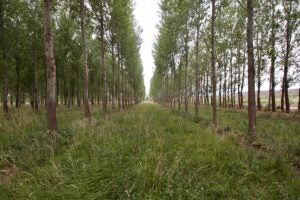A study from agroforestry company Propagate and environmental nonprofit The Nature Conservancy estimates there are between 14 million and 62 million acres of potential opportunity to expand silvopasture practices in the eastern United States. This level of integrating trees and grazing livestock operations on the same land, according to researchers, could capture between 4.9 million and 25.6 million metric tons of carbon dioxide emissions per year.
At full adoption, that’s equal to taking 5.7 million gas-powered vehicles off the road; it would also increase the global footprint of silvopasture by an estimated 6 percent.
The research paper, Silvopasture Offers Climate Change Mitigation and Profit Potential for Farmers in the Eastern United States, was recently published in the peer-reviewed journal Frontiers in Sustainable Food Systems.
“Agroforestry is a powerful yet underutilized natural climate solution in U.S. agriculture,” said Clare Kazanski, Ph.D., senior scientist for The Nature Conservancy and a co-author of the paper. “Silvopasture, one of several agroforestry practices, was the focus of our research, which demonstrates great potential for farmers to explore different options for increasing their revenue streams while helping to address climate change.” Silvopasture is the integration of trees, forage, and grazing livestock on the same piece of land.
The researchers assessed the carbon and economic implications of adding nine distinct silvopasture systems, varying by species and product (timber, nuts, and fodder for livestock), to existing pastures in historically forested areas of the eastern United States. They did this by calculating the carbon sequestration rates, costs, and revenues for each of the nine silvopasture systems and how economic outcomes would change if landowners were paid for carbon accumulation. The research considered two adoption scenarios: one a base scenario and the other a full adoption scenario that modeled what might be possible with current demand versus increased demand for the different timber, nut, and fodder products.

“The decision to commit to a substantial capital expenditure, such as silvopasture adoption, is never something farmers take lightly, and land managers need better data in order to make informed decisions,” said Harry Greene, chief research officer at Propagate and lead author on the paper. “Ideally, publishing this research will also help lenders, agencies, NGO’s, and other sources of capital understand the returns of trees, as they seek to do with any other fixed asset.”
Climate Mitigation Potential
The researchers found that 25.6 million metric tons of carbon emissions could be captured every year, when considering the full adoption scenario (62 million acres of new silvopasture systems). Silvopasture systems that generally offer the most mitigation potential are not necessarily those with the highest per-acre rates of carbon accrual, but instead those with the highest estimated acreage potential demand. For instance, given the high and ongoing demand for feed (the main input in beef production), fodder species (mulberry and willow) have the most mitigation potential because they could expand to cover the greatest area, even though they have the lowest per-acre carbon accrual rates.
The research estimates the carbon accrual in aboveground and belowground biomass. “Aboveground biomass is the main source of increased carbon in agroforestry systems, especially silvopasture,” Kazanski said, noting that additional research on possible soil carbon increases from silvopasture could demonstrate additional mitigation potential.
Profit Potential
This research demonstrates the financial upside of adding trees to grazing systems, which were once forested areas. “Silvopasture will be adopted to the extent that it is profitable and there is market demand for products from silvopasture systems,” Greene said.
Given the spatial analysis that identified 14 million to 62 million acres available for expansion, the researchers concluded that silvopasture practices can be profitable (6-14 percent IRR in some cases) without any additional market drivers, such as a price on carbon. Therefore, adoption is not constrained by land availability but likely by a combination of factors including education and specific systems designed for a farm’s unique operations.

“It’s important to understand what a given price on carbon — and a successful payment — can have on accelerating the adoption of silvopasture,” said Greene. “Different tree species require different amounts of carbon payment to come online with farmers, depending on the species’ growth rate and non-carbon yields. Prices likely need to increase to $80-90 per ton if farmers are to pay real attention to the idea of planting large long-lived trees in their pastures.”
Greene also pointed out that mulberry, willow, and other fodder species provide a good return without carbon incentives, noting a great uptake in Latin America and Australia.


